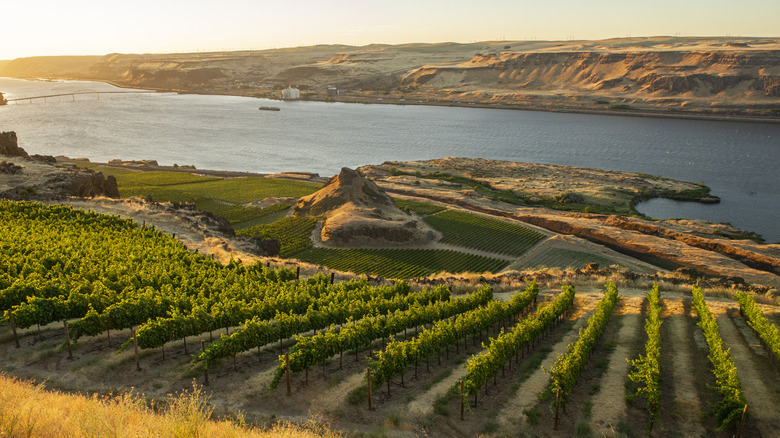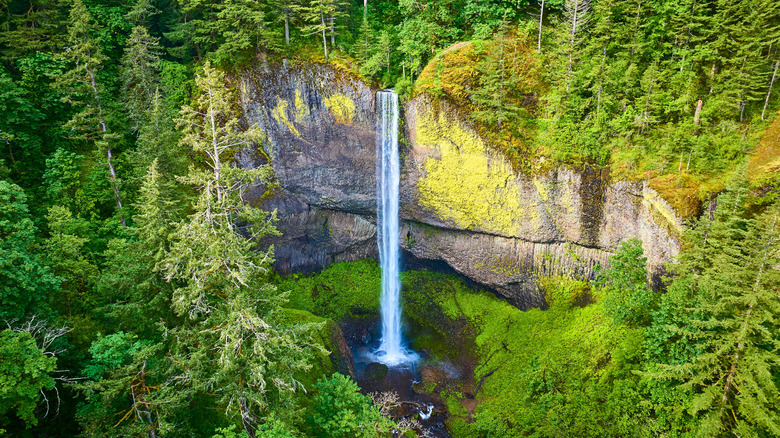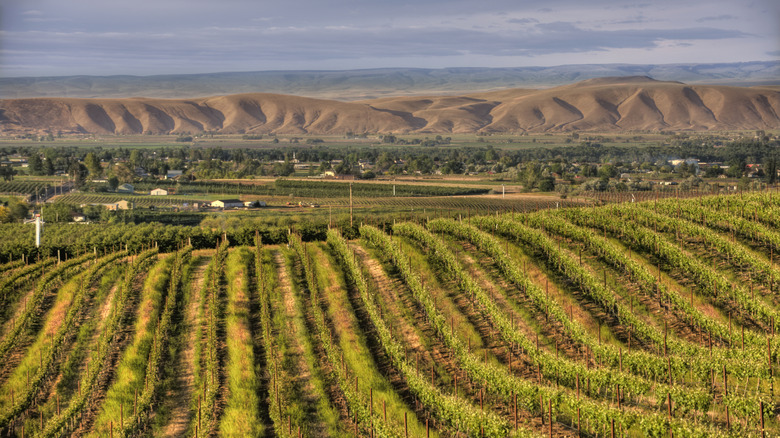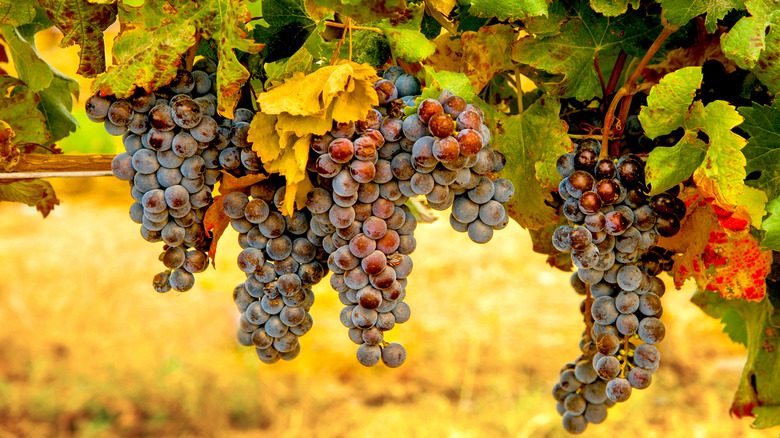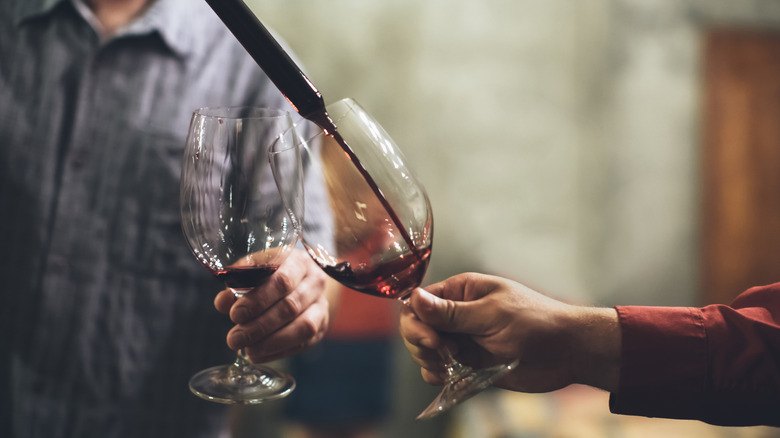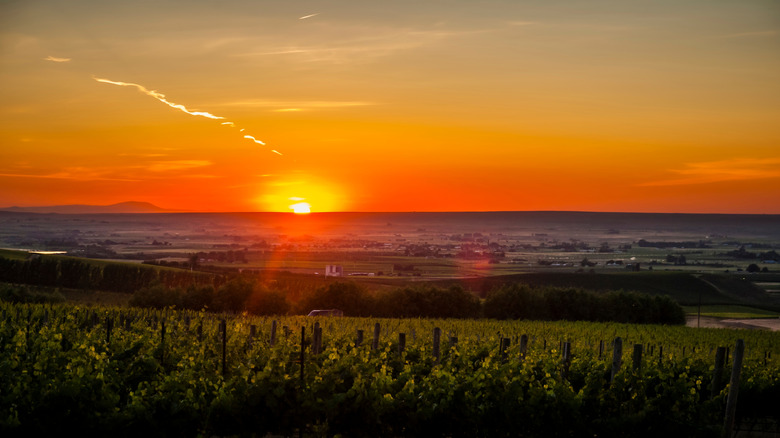Washington's Wine And Waterfall Road Trip Offers Sweet Sips And Stunning Sites In One Scenic Route
There is an astonishing number of wineries in Washington State: 900 according to recent estimates. Though arguably not as famous as more celebrated wine-growing regions in North America, such as California and Florida, the history of wine in Washington goes all the way back to the 1800s — though the exact date is debated. Online wine merchant VINVM says the first grapes were planted in Fort Vancouver in 1825, Ron Irvine's book "The Wine Project" generally points to the 1820s (via The Seattle Times), and Discover Washington Wine says the first grapes in the state were grown in Walla Walla in the 1850s. Regardless of where it started, the industry grew toward the end of the century as European immigrants arrived in the United States, bringing their winemaking skills with them. Washington state wine exploded in popularity and production in the latter half of the 20th century.
Washington is perfect for scenic road trips taken at a meandering pace as you soak in the flavors and aromas that the state's wineries have on offer. The region is particularly famous for producing merlot as well as cabernet sauvignon, but there are plenty of hidden secrets to uncover on the Washington wine trail.
But it's not all wine. One five-day itinerary suggested by Moon Travel Guides' Matthew Lombardi begins on the Oregon border near Portland and focuses on several of the state's famous waterfalls, suggesting cultural and gastronomic sites you may want to visit on the way. The route is ideal for those traveling by car, though RVs are also served by several RV parks along the way. Make sure that you plan your winery visits in advance, and either bring a designated driver or take care not to drive while intoxicated.
Day 1: South of the river
The Moon itinerary begins with a few of Oregon's natural wonders before you cross the river into Washington. Writer Matthew Lombardi recommends making time on the way to visit the Columbia River Gorge within Guy W. Talbot State Park. You can hike the 2.1-mile trail to see the stunning Latourell Falls, that boast an almost 250-foot drop. You can also visit the historic Bonneville Dam before crossing over into Washington at Cascade Locks and heading to Beacon Rock, a nearly 850-foot ascent that gives beautiful panoramic views of the area. Make sure you have a park pass if you're going to try the 1.8-mile hike.
Lombardi recommends heading back across the river to dine at a brewpub in Hood River. However, why not visit a winery? There are dozens of wineries on both sides of the Columbia River, but seeing as we are focusing on Washington, we will focus only on growers on the north bank. Le Doubblé Troubblé Wine Co. on East Jewett Boulevard in White Salmon is a tasting room open 12 p.m. to 8 p.m. Thursday to Monday that also offers small bites like charcuterie boards. The winery specializes in pinot noir from the Willamette Valley and the Columbia Gorge but has many other varieties on offer to keep your palate entertained. Visitors love its unpretentious atmosphere and friendly staff, and it is just a mile away from the nearest Best Western.
Day 2: The road to Yakima
The next day sees the route continue east on the north side of the Columbia River, where after around 40 miles you will arrive at Maryhill Museum of Art, that writer Matthew Lombardi praises as one of Washington's "most remarkable cultural institutions" in his Moon itinerary. Open between mid-March and mid-November including federal holidays, the former mansion has an extensive permanent collection that includes work by famed sculptor Auguste Rodin as well as sections devoted to indigenous art and French haute couture, including a sizeable sculpture park and some additional rotating exhibitions.
From there, the route takes you past the Goldendale Observatory, which is worth a stop if you have time, up U.S. Route 97 to the town of Yakima. The route takes you through the picturesque Yakima Indian Reservation, but if you want to take a wine-oriented pitstop, you can diverge from the 97 onto the 22 and past Route 82 to the Yakima Valley Highway, where you can stop off at nearby wineries. This includes the much-feted Fortuity Cellars, that opened in 2017. After your detour, you can rejoin Route 82 heading to Yakima. There, be sure to stop in at Yakima Valley Vintners, a teaching winery and tasting room offering wines made by their students. If you're going to be drinking, though, make sure that you end your day in Yakima and consider getting a cab to and from the winery so you're not driving under the influence.
Ending the day in Yakima is ideal because of the wide range of accommodation options on offer. Hotel Maison Yakima Tapestry Collection by Hilton is a smart modern option in a gorgeous historic building, while the Hotel Y represents a great value option with all the benefits of a boutique hotel. The latter also offers a complimentary breakfast, while the Hilton charges for its continental breakfast.
Day 3: The Yakima Valley
Spend some time in Yakima enjoying the great brunch spots like the Apple Tree Restaurant and touring the orchards and bake shop at Johnson Orchards. Around midday, head east from Yakima toward the Yakima Valley — you would have already skirted it if you passed Route 82 on day two — and the Rattlesnake Hills. Here, you're in wine-tasting heaven, with wineries down every route that welcome guests for flights of local produce. The Moon itinerary recommends Owen Roe for the quality of the wines on offer, and for good reason — it's ranked 15th overall out of the hundreds of wineries in the state on Tripadvisor. Owen Roe Winery's tasting room on Gangl Road in Wapato is open from 11 a.m. until 5 p.m. Friday to Monday, with guided tastings taking place hourly. Moon's Matthew Lombardi describes the nearby Two Mountain Winery as having the "most fun tasting room," but credits all the wineries he has visited as being hospitable and friendly.
The route continues east to the Tri-Cities area containing Kennewick, Pasco, and Richland. Here, you can ascend the 5.9-mile trail up picturesque Red Mountain. Or if you're not up for a hike, you can take Lombardi's recommendation and take a tour of Hanford Engineer Works, which played a role in the Manhattan Project in the 1940s. For an early evening tasting, try family-owned Longship Cellars in Richland, specializing in barrel-aged reds such as tempranillo and malbec, or the boutique J. Bookwalter Winery on Tulip Lane, which was established back in 1983. The latter also operates the Fiction and Fable Craft Bars, which are great spots to stop for lunch or dinner and are open late. There are plenty of places to stay in the Tri-Cities. LivAway Suites in Richland is simple, practical, and modern, while The Study in Kennewick is a cozy vacation rental with a literary theme.
Day 4: Walla Walla
Follow the northern bank of the Columbia River south on Route 12, and continue east from the Tri-Cities for around 50 miles. You will find yourself in Walla Walla, another Washington region defined by its wineries. However, with most wineries opening just before noon, setting off early means you can fit in another stunning waterfall site: Palouse Falls State Park. The park is an hour and 20 minutes northeast of the Tri-Cities on Route 395 and just an hour from Walla Walla. The park is home to several trails leading into a gaping canyon. Be sure not to miss the dramatic views of the powerful Palouse Falls, one of the area's most impressive sights.
Famous for its charming small-town main street, Walla Walla is packed with top-class tasting rooms. The Scandinavian-inspired Gard, which offers free tasting flights with a two-bottle purchase, and a tempting selection of charcuterie, paninis, and craft beer. You can also visit Caprio Cellars, whose tasting room is based on their estate. Caprio focuses on Bordeaux varietal blends, as well as delicious dishes to pair with the wine.
The Moon itinerary recommends two historic sites to check out between tastings. The first is Whitman Mission National Historic Site, dedicated to preserving the history of the pivotal Oregon Trail way-stop. The second is Fort Walla Walla Museum, located in the 19th-century fort that also played a key role for Oregon Trail travelers. Walla Walla isn't short of top-class restaurants, though — Brasserie Four on East Main Street and Saffron Mediterranean Kitchen on West Main Street are the two that Moon's Matthew Lombardi recommends. The Fat Duck Inn on Catherine Street is a popular Walla Walla bed and breakfast that boasts delicious made-to-order breakfasts. In the summer, you can dine in the bed and breakfast's outdoor garden.
Day 5: Leaving wine country
Walla Walla is the final destination of the Washington wine country itinerary laid out by Moon, and if you're not in any rush to hit the road, the town offers many great breakfast options to help round off your trip. The historic Maple Counter Cafe on East Alder Street is open at 7 a.m. and is known for its delicious egg entrees and buttermilk pancakes, made with local ingredients. Maple Counter also makes its own syrup. Meanwhile, Clarette's Restaurant on South Touchet Street is open at 6 a.m. and offers a range of satisfying breakfast platters such as the Country Biscuit Breakfast, which are served all day and will set you up for your trip home no matter what direction you're headed next.
But what if you're not ready to go home yet? If you're looking to continue your adventure in Washington, you could always drive the U.S. Pacific Northwest region's Cascade Loop to see incredible mountains, lakes, and island views.
